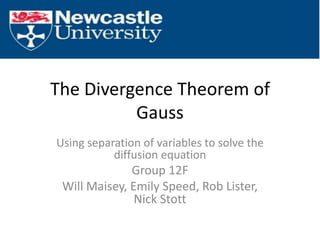
Diffusion Equation Separation Of Variables (if you\'re bored)
- 1. The Divergence Theorem of Gauss Using separation of variables to solve the diffusion equation Group 12F Will Maisey, Emily Speed, Rob Lister, Nick Stott
- 2. Recap (Heat Equation): The heat equation (a specified type of diffusion equation) is an important partial differential equation which describes the distribution of heat (or variation in temperature) in a given region over time. For a function u(x,y,z,t) of three spatial variables (x,y,z) and the time variable t, the heat equation is; Or equivalently; Where α is a constant.
- 3. Guillaume François Antoine, Marquis de l’Hôpital (1661-1704) Guillaume François Antoine a French mathematician, otherwise known as Guillaume de l’Hôpital, was the first to use the method of separation of variables. l'Hôpital was born in Paris, France. He initially had planned a military career, but poor eyesight caused him to switch to mathematics. He solved the brachistochrone problem. His name is perhaps best known for the rule for calculating the limiting value of a fraction whose numerator and denominator either both approach zero or both approach infinity, however, he is presumed not to be the discoverer of the rule.
- 4. Guillaume François Antoine, Marquis de l’Hôpital (1661-1704) He is also the author of the first European textbook on differential calculus, l'Analyse des Infiniment Petits pour l'Intelligence des Lignes Courbes. In 1694 he forged a deal with Johann Bernoulli. The deal was that l'Hôpital paid Bernoulli 300 Francs a year to tell him of his discoveries, which l'Hôpital described in his book. In 1704, after l'Hôpital's death, Bernoulli revealed the deal to the world, claiming that many of the results in l'Hôpital's book were due to him. The widespread story that l'Hôpital tried to get credit for inventing de l'Hôpital's rule is false: he published his book anonymously, acknowledged Bernoulli's help in the introduction, and never claimed to be responsible for the rule.
- 5. Separation of Variables: Separation of Variables is a method of solving O.D.Es or P.D.Es, whereby an equation of two variables is ‘separated’ into a product of two equations. This can be split into independent ordinary differential equations which we can solve. u(x,t) X(x) T(t)
- 6. Separation of Variables: Once separated and applied to the original equation, the result can be written solely in terms of each variable on either side of the equality sign. This tends to include derivative terms. The only way the equality can hold in terms of different variables is if the two sides are equal to a constant. This is usually denoted λ. X(x) = T(t) = λ
- 7. Separation of Variables: This lambda can then be incorporated into each side to form two separate O.D.E’s. X(x) - λ = 0 T(t) - λ = 0 The two equations are solved separately. It is important to remember that separation of variables was used at the beginning, and so the two final equations must be written as a product. The final solution is then back in the form u(x,t).
- 8. Separation of variables to solve the diffusion equation: The diffusion equation for heat flow is: The question we are posed is: Solving the diffusion equation for temp u(x,t) in a 1d bar with insulated Ends and initial temperature So we will consider the equation With an example similar to that shown opposite
- 9. Separation of variables to solve the diffusion equation: Solution: We can re-write U(x,t) = X(x)T(t), x being the space variable [0,L] and t the time variable t ≥ 0 So Given substituting U(x,t) into the heat equation we get: So as for two differential equations to be equal they must both equal the same constant, here that is -λ.
- 10. Separation of variables to solve the diffusion equation: So For the solution to hold we require λ>0 Therefore solving for X we see that: And solving for T we see that: Using our boundary conditions and the fact that we do not require a trivial solution, we can see that: And
- 11. Separation of variables to solve the diffusion equation: We can hence see that the general form of U(X,T) is: We can solve for the coefficients, using the initial condition: to obtain the solution.
- 12. Fourier Series: Using Fourier Series, we can determine the coefficients: For n≥1, it would be better solved if we split it into 2 integrals:
- 13. Fourier Series: However, first we must determine A0:
- 14. Fourier Series: Using the product rule, for the first integral:
- 15. Fourier Series: And for the second integral:
- 16. Fourier Series: Summing the two together gives us An: So therefore we obtain:
- 17. Our Solution: So therefore, we can determine the solution as: The validity of this solution can be checked using Maple, using a sufficient size for L:
- 18. Maple: In order to give a graphical representation, we must give L a Numerical value (so Maple can recognise it as a constant). So say, L = 10, and n ranging from 1 to infinity: Inputting into Maple: We obtain:
- 19. Maple: Finally, using the plot function: The following graph is produced: This is the function: So as f(x)=g(x) as L=10, the solution is valid.
- 20. Thank you for listening